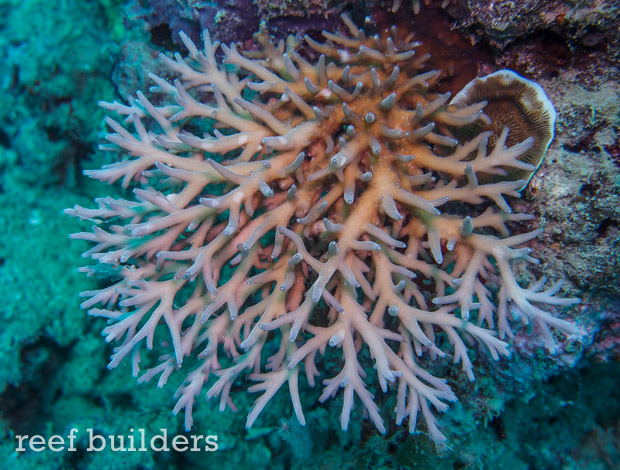As far as cool “mythical” acros go, for us Acropora suharsonoi has always been one of the be-all unique and beautiful small polyp stony corals for the home aquarium. As an SPS lover, getting our hands on this species for the first time in 2005-2006 was a momentous occasion rivaled only by seeing the species in person, in the wild, and taking lots of notes on where it lives and what lives with it.

On the Fluval Sea Flores Expedition around Komodo and Rinca islands we were so close to the population center of Acropora suharsonoi that we expected to see some colonies but what we observed was a veritable spread of the great elongated-branch Acro in its myriad of forms. While we’ve featured the famous Suharsonoi Acro from an aquarium point of view before, this is the first time observations of this species in the wild. The first notable thing we can say about A. suharsonoi is that it lives in a wholly unremarkable habitat, if anything it is definitely middle of the road in terms of environmental parameters. You won’t find A. suharsonoi living in crystal clear or shallow waters where the light is direct and bright. But you also won’t find it living too much beyond 50 feet deep where water flow is reduced and the available light has dropped to a fraction of what it is at the surface.


Rather the most likely place you’ll find Acropora suharsonoi is an average habitat with modest water current at a depth between 30 and 50 feet – in shallower waters it will often grow on slopes and small vertical reef structures where the coral can receive bright light but for only part of the day since the reef structure will shade it from direct light. What is equally noteworthy about where this coral lives is the corals it lives with. In Flores it was possible to observe this species living in close proximity with related corals such as A. lokani, A. elegans, A. derawanensis, A. jacquelinae, A. caroliniana and A. speciosa.
Some unrelated corals which enjoyed the close company of A. suharsonoi include low energy corals such as Leptoseris, Anacropora, Pavona, Mycedium, and especially lots of thin-branching birdnest corals of the genus Seriatopora. On the extreme ends of the habitat spectrum we occasionally saw A. suharsonoi living in shallower water; these colonies tended to be smaller with stouter upright branches as in the image above. In these higher energy locations this coral species really gravitated towards protected habitats, usually staying quite small and one occasion we even saw a complete nice colony of A. suharsonoi growing in the direct shade of a large tabling Acro.

Meanwhile in deeper habitats or more turbid environments the colonies of A. suharsonoi grew in a much more plating fashion. These low-energy Suharsonoi were almost devoid of any upright growing branches and the margins of the colonies grew almost downwards making the colony look something like the roots of a land plant such as in the specimen pictured below. One of the most encouraging aspects of seeing so many Acropora suharsonoi in the wild is really getting a feel for the kind of environment this coral prefers and how to mimic its preferences in the home aquarium. The most obvious parameter that will make this species thrive is a decent amount of indirect light – it still likes it bright but direct lighting with hotspots are likely to make it bleach.

Speaking of bleaching, the really cool observation we made of this species in the wild is that it is generally abundant and in great health. At some point we stopped taking pictures of this species in Flores and all the colonies we saw were in great health with no signs of bleaching, recession or anything but generally harmony with its environment. We hope this overview fo this iconic ‘deepwater acro’ species will help give reefers a better understanding of how to be successful with this coral in home aquariums and if you have any specific questions, let them fly in the comments below.



